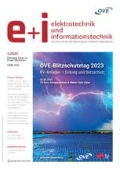Abstract
The nature and quality of artificial lighting are becoming more and more recognized and debated issues concerning their impact on comfort, well-being and even human’s health (chronobiology). Therefore, the target must be to emulate natural (sun) light for indoor illumination. In this paper parameters which are responsible for the nature and quality of light sources are elaborated. Leading edge high quality light sources, realized by light emitting diodes (LEDs) for emulating natural light, are presented.
The junction temperature of electroluminescence devices is a key parameter which influences emission wavelength, light output (power efficiency), light degradation and lifetime of the LEDs. We present experimental data and a model which allows one to derive the junction temperature of LEDs under operation.
Zusammenfassung
Die Natur und die Qualität künstlicher Lichtquellen und deren Auswirkungen auf Komfort, Wohlbefinden und Gesundheit werden immer stärker wahrgenommen und diskutiert (Chronobiologie). Daraus folgt nahezu zwingend die Forderung, natürliches (Sonnen-)Licht im Bereich der Innenraumbeleuchtung nachzubilden. In dieser Arbeit werden wesentliche Parameter, welche die Natur und die Qualität von Lichtquellen bestimmen, behandelt. Präsentiert werden technologisch führende und hoch qualitative Lichtquellen zur Erzeugung von „natürlichem“ Licht unter Verwendung von Licht emittierenden Dioden (LEDs).
Die Temperatur der Grenzschicht ist ein Schlüsselparameter, der die Emissionswellenlänge, die Lichtausbeute (Effizienz), die Lichtdegradation und letztlich die Lebensdauer von LEDs bestimmt. Wir präsentieren Messergebnisse zur Grenzschichttemperatur und ein Modell, welches erlaubt, die Temperatur der Grenzschicht der LED im Betrieb zu bestimmen.








Similar content being viewed by others
References
Barkmann, C., Wessolowski, N., Schulte-Markwort, M. (2012): Applicability and efficacy of variable light in schools. Physiol. Behav., 105(3), 621–627.
Bieske, K., Gall, D., Vandahl, C., Dierbach, O. (2006): Influence of artificial daylight on gerontopsychiatric care of elderly people. In CIE 2cd expert symposium on light and health, CIEx 031:2006, 7.-8.9. Ottawa.
Brainard, G. C., Hanifin, J. P., Greeson, J. M., Byrne, B., Glickman, G., Gerner, E., Rollag, M. D. (2001): Action spectrum for melatonin regulation in humans: evidence for a novel circadian photoreceptor. J. Neurosci., 21(16), 6405–6412.
Braunstein, R. (1955): Radiative transitions in semiconductors. Phys. Rev., 99(6), 1892–1893.
Cajochen, C. (2007): Alerting effects of light. Sleep Med. Rev., 11(6), 453–464.
Cajochen, C., Munch, M., Kobialka, S., Krauchi, K., Steiner, R., Oelhafen, P., Orgul, S., Wirz-Justice, A. (2005): High sensitivity of human melatonin, alertness, thermoregulation, and heart rate to short wavelength light. J. Clin. Endocrinol. Metab., 90(3), 1311–1316.
Cameron, J. R., Skofronick, J. G. (1978): Medical physics (pp. 337–384). New York: Wiley.
Figueiro, M. G., Rea, M. S. (2010): The effects of red and blue lights on circadian variations in cortisol, alpha amylase, and melatonin. Int. J. Endocrinol., 2010, 829351.
Figueiro, M. G., Appleman, K., Bullough, J. D., Rea, M. S. (2006): A discussion of recommended standards for lighting in the newborn intensive care unit. J. Perinatol., 26, 19–26.
GE Lighting (2003). CMH single ended G8.5 product information for OEMs. General Electric Company. Ver. 1.0.
Haitz, R., Tsao, J. Y. (2011): Solid-state lighting: ‘The case’ 10 years after and future prospects. Phys. Status Solidi, a Appl. Mater. Sci., 208(1), 17–29.
Hattar, S., Liao, H. W., Takao, M., Berson, D. M., Yau, K. W. (2002): Melanopsin-containing retinal. ganglion cells: architecture, projections, and intrinsic photosensitivity. Science, 295(5557), 1065–1070.
Hofstra, W. A., Weerd, A. W. D. (2008): How to assess circadian rhythm in humans: a review of literature. Epilepsy Behav., 13(3), 438–444.
Holonyak, N., Bevacqua, S. F. (1962): Coherent (visible) light emission from Ga(As1−x P x ) junctions. Appl. Phys. Lett., 1(4), 82–83.
Lockley, S. W., Brainard, G. C., Czeisler, C. A. (2003): High sensitivity of the human circadian melatonin rhythm to resetting by short wavelength light. J. Clin. Endocrinol. Metab., 88(9), 4502–4505.
Mills, P. R., Tomkins, S. C., Schlangen, L. J. (2007): The effect of high correlated colour temperature office lighting on employee wellbeing and work performance. J. Circadian Rhythms, 5(2).
Morita, T., Tokura, H. (1996): Effects of lights of different color temperature on the nocturnal changes in core temperature and melatonin in humans. Appl. Hum. Sci., 15(5), 243–246.
Philips (2012): Lamp Description MasterColor® CDM ED28 standard.
Phipps-Nelson, J., Redman, J. R., Dijk, D. J., Rajaratnam, S. M. W. (2003): Daytime exposure to bright light, as compared to dim light, decreases sleepiness and improves psychomotor vigilance performance. Sleep, 26(6), 695–700.
Pimputkar, S., Speck, J. S., DenBaars, S. P., Nakamura, S. (2009): Prospects for LED lighting. Nat. Photonics, 3(4), 180–182.
Round, H. J. (1907): A note on carborundum. Electr. World, 19, 309.
Schanda, J., Dányi, M. (1977): Correlated color temperature calculations in the CIE 1976 chromaticity diagramm. Color Res. Appl., 2(4), 161–163.
Schubert, E. F. (2006b): Light-emitting diodes, 2nd ed. (pp. 332–366). Cambridge: Cambridge University Press.
Schubert, E. F., Kim, J. K., Luo, H., Xi, J. Q. (2006a): Solid-state lighting—a benevolent technology. Rep. Prog. Phys., 69(12), 3069–3099.
Steele, R. V. (2007): The story of a new light source. Nat. Photonics, 1(1), 25–26.
Sust, C. A., Dehoff, P., Lang, D., Lorenz, D. (2012): Verbesserte Lebensqualität für demente Bewohner: Das Forschungsprojekt St. Katharina in Wien. Zumtoble Research.
Thapan, K., Arendt, J., Skene, D. J. (2001): An action spectrum for melatonin suppression: evidence for a novel non-rod, non-cone photoreceptor system in humans. J. Physiol., 535(1), 261–267.
Xi, Y., Schubert, E. F. (2004): Junction-temperature measurement in GaN ultraviolet light-emitting diodes using diode forward voltage method. Appl. Phys. Lett., 85(12), 2163–2165.
Xi, Y. G., Gessmann, T., Xi, J. Q., Kim, J. K., Shah, J. M., Schubert, E. F. (2005a): Junction temperature in ultraviolet light-emitting diodes. Jpn. J. Appl. Phys., 44(10), 7260–7266.
Xi, Y., Xi, J. Q., Gessmann, T., Shah, J. M., Kim, J. K., Schubert, E. F., Fischer, A. J., Crawford, M. H., Bogart, K. H. A., Allerman, A. A. (2005b): Junction and carrier temperature measurements in deep-ultraviolet light-emitting diodes using three different methods. Appl. Phys. Lett., 86(3), 031907.
Author information
Authors and Affiliations
Corresponding author
Rights and permissions
About this article
Cite this article
Hetzel, R., Tasch, S. & Leising, G. Tunable natural light realized by phosphor-innovation light-emitting-diode technology. Elektrotech. Inftech. (2012). https://doi.org/10.1007/s00502-012-0105-1
Received:
Accepted:
Published:
DOI: https://doi.org/10.1007/s00502-012-0105-1




